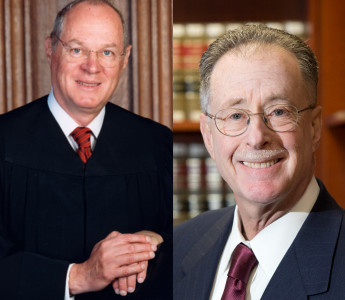March 19, 2017
Peña-Rodriguez v. Colorado, 580 U.S. ___ (2017) (Kennedy, J.).
Response by Professor Cynthia Lee
Geo. Wash. L. Rev. On the Docket (Oct. Term 2016)
Slip Opinion | Washington Post | SCOTUSblog
Peña-Rodriguez v. Colorado: The Court’s New Racial Bias Exception to the No-Impeachment Rule
On March 6, 2017, the Supreme Court adopted a constitutional exception to the no-impeachment rule found in Rule 606(b) of the Federal Rules of Evidence and followed in forty-two jurisdictions. In Peña-Rodriguez v. Colorado,1 the Court held that post-verdict juror testimony on racial bias expressed by a juror during deliberations may be allowed when “a juror makes a clear statement that indicates he or she relied on racial stereotypes or animus to convict a criminal defendant.”2 Grounding the decision in the Sixth Amendment right to an impartial jury, Justice Kennedy, writing for a 5-3 majority of the Court, notes that “[n]ot every offhand comment indicating racial bias or hostility will justify setting aside the no-impeachment bar to allow further judicial inquiry.”3 Justice Kennedy explains that “there must be a showing that one or more jurors made statements exhibiting overt racial bias that cast serious doubt on the fairness and impartiality of the jury’s deliberations and resulting verdict.”4 To be exempt from the no-impeachment rule, “the statement must tend to show that racial animus was a significant motivating factor in the juror’s vote to convict.”5
Peña-Rodriguez is a significant decision, marking the first time the Supreme Court has created a constitutional exception to the no-impeachment rule. The no-impeachment rule is an evidentiary rule that protects jury deliberations from post-verdict inquiry. Under this rule, “a juror may not testify about any statement made or incident that occurred during the jury’s deliberations; the effect of anything on that juror’s or another juror’s vote; or any juror’s mental processes concerning the verdict or indictment.”6
In two previous cases, litigants tried, but failed, to get the Court to recognize a constitutionally based exception to the no-impeachment rule. In Tanner v. United States,7 the defendant sought to present evidence—discovered after the verdict was entered—that during the trial some jurors were under the influence of alcohol and others were under the influence of marijuana and cocaine, violating his Sixth Amendment right to a trial by a fair and impartial jury.8 The Court declined to create a Sixth Amendment exception to the no-impeachment rule for evidence of drug and alcohol use, expressing concern that allowing such an exception would disrupt the finality of the verdict, undermine juror willingness to return an unpopular verdict, and undermine the community’s trust in the jury system.
The Tanner Court outlined four existing safeguards that it felt adequately protect a defendant’s Sixth Amendment right to an impartial jury. First, before trial, voir dire gives the judge and the attorneys an opportunity to question prospective jurors to ensure impartiality.9 Second, during the trial, the court, counsel, and court personnel can observe juror misconduct for themselves.10 Third, before the verdict is entered, jurors can report juror misconduct to the court.11 Finally, after the trial is over, evidence of misconduct can be used to impeach the verdict as long as it is proven by means other than juror testimony.12 Given these safeguards, the Court felt a constitutional exception to the no-impeachment rule was unwarranted.
In 2014, the Court again declined to create a constitutional exception to the no-impeachment rule. Warger v. Shauers13 was a civil case involving an accident between a motorcycle and a truck. Gregory Warger was seriously injured after a truck driven by Randy Shauers struck Warger’s motorcycle from behind. Warger sued Shauers for negligence, but lost. After the verdict was entered, one of the jurors contacted Warger’s counsel, stating that the jury foreperson had told the other jurors during jury deliberations that her daughter had been at fault in a fatal car accident and that a lawsuit would have ruined her life. Armed with an affidavit from this juror, Warger tried to get the trial court to grant a new trial on the ground that the jury foreperson had lied during voir dire by failing to disclose her pro-defendant bias, violating his Sixth Amendment right to a fair and impartial jury. While declining to create a Sixth Amendment exception to the no-impeachment rule, the Warger Court noted that it might recognize an exception based on bias in the future if presented with a case involving “juror bias so extreme that, almost by definition, the jury trial right has been abridged.”14
That case presented itself in Peña-Rodriguez v. Colorado. In Peña-Rodriguez, two teenage sisters were allegedly sexually assaulted in the bathroom of a horse racing facility.15 The girls told their father of the alleged sexual assault and identified their attacker as an employee of the racetrack. Each sister separately identified Peña-Rodriguez as the man who had assaulted her. Peña-Rodriguez was charged with harassment, unlawful sexual contact, and attempted sexual assault on a child. The jury found Peña-Rodriguez guilty of unlawful sexual assault and harassment, but could not reach agreement on the charge of attempted sexual assault on a minor.
After the guilty verdict was entered and the jury discharged, two jurors told Peña-Rodriguez’s attorney that another juror, Juror H.C., had expressed anti-Mexican bias during deliberations. According to the two jurors, Juror H.C. told the other jurors that he “believed the defendant was guilty because, in [his] experience as an ex-law enforcement officer, Mexican men had a bravado that caused them to believe they could do whatever they wanted with women.”16 The two jurors also claimed that Juror H.C. said, “I think he did it because he’s Mexican and Mexican men take whatever they want.”17 According to the two jurors, Juror H.C. added that in his experience, “nine times out of ten Mexican men [are] guilty of being aggressive toward women and young girls.”18 Allegedly, Juror H.C. also said he did not find the defendant’s alibi witness credible because he was “an illegal,” despite the fact that defendant’s alibi witness had testified during the trial that he was a lawful permanent resident of the United States.19
It is noteworthy that Justice Kennedy, who has authored every major decision affirming the rights of gays and lesbians since 1996,20 authored this race-progressive decision. Denouncing Juror H.C.’s comments, Justice Kennedy spends several paragraphs discussing the need to eliminate racial discrimination in the justice system and “rise above racial classifications that are so inconsistent with our commitment to the equal dignity of all persons.”21 Justice Kennedy offers several additional rationales to support the Court’s newly created exception to the no-impeachment rule for racial bias, which are examined in turn below.
First, Justice Kennedy attempts to distinguish this case from Tanner and Warger, saying that the behavior in those cases involved “anomalous behavior from a single jury—or juror—gone off course.”22 Justice Kennedy opines that “neither history nor common experience show that the jury system is rife with mischief of these or similar kinds.”23 He continues, “[t]he same cannot be said about racial bias, a familiar and recurring evil that, if left unaddressed, would risk systemic injury to the administration of justice.”24
The problem with Justice Kennedy’s attempt to distinguish this case from Tanner and Warger is that one could also say that Peña-Rodriguez involved “anomalous behavior” from a single juror “gone off course.” It is far from clear that the jury system is rife with jurors, like Juror H.C., who are willing to express racially biased comments to other jurors during deliberations. Indeed, the available social science research suggests that many, if not most, individuals today are not overtly racist, but instead hold egalitarian beliefs.25 While these egalitarian beliefs may conflict with a juror’s implicit biases, a juror who believes that it is wrong to discriminate based on race or ethnicity is unlikely to make comments of the sort made by Juror H.C. Indeed, it is probably the rare case in which a juror makes racially biased comments of the kind made by Juror H.C.
Second, Justice Kennedy suggests that the Tanner safeguards are less effective at rooting out racial bias than other kinds of bias because “[t]he stigma that attends racial bias may make it difficult for a juror to report inappropriate statements during the course of juror deliberations.”26 Justice Alito, dissenting, notes that the Court provides no empirical support for this assertion.27 It seems obvious, however, that a juror might hesitate to report another juror’s misconduct during deliberations, especially if the misconduct involves allegations of racial bias, but be willing to come forward after the case is over and it is no longer necessary to interact with the other juror.
Third, Justice Kennedy explains that a constitutional exception for racial bias “is necessary to prevent a systemic loss of confidence in jury verdicts, a confidence that is a central premise of the Sixth Amendment trial right.”28 The problem with this rationale is that one could also say that a constitutional exception to address drug and alcohol use by jurors during trial, as occurred in the Tanner case, is necessary to prevent a systemic loss in confidence in jury verdicts. If the public were to find out that verdicts were being rendered by jurors who were drunk, stoned, or high during trial, this might lead to a systemic loss of confidence in jury verdicts. This is not a reason to reject the holding of Peña-Rodriguez, but perhaps a reason to reconsider Tanner.
The main reason for the Court’s creation of a racial bias exception to the no-impeachment rule appears to be its concern that the Nation “continue to make strides to overcome race-based discrimination.”29 This is an important and laudable goal. The rule the Court fashions to achieve this goal, however, may not have as significant an impact on the influence of racial bias on jury verdicts as the Court hopes. In most cases, there will not be “clear evidence” of racial bias. Most jurors with racially biased thoughts will keep those thoughts to themselves. Moreover, the social cognition research on implicit racial bias suggests that unless jurors are made aware of their implicit biases and take steps to overcome those biases, they will continue to associate Black and Brown individuals with negative racial stereotypes, and not even realize they are doing so.30
Peña-Rodriguez is an important decision. As a symbolic expression of the Court’s position that racial bias in the jury system must not be tolerated, it is a positive step forward. As a vehicle for minimizing racial bias, however, the case may be of limited value in light of the fact that most bias today is implicit, not explicit.
- No. 15-606, slip op. (U.S. Mar. 6, 2017).
- Id. at 17.
- Id.
- Id.
- Id.
- Fed. R. Evid. 606(b)(1). Rule 606(b) recognizes three exceptions to its general prohibition against juror testimony about matters that occurred or statements made during jury deliberations. Under 606(b)(2), a juror may testify about whether: (1) extraneous prejudicial information was improperly brought to the jury’s attention; (2) an outside influence was improperly brought to bear upon any juror; or (3) a mistake was made in entering the verdict on the verdict form. Fed. R. Evid. 606(b)(2).
- 483 U.S. 107 (1987).
- The Tanner Court declined to find that the influence of drugs or alcohol on a juror was an “outside influence” improperly brought to bear on any juror, one of the three exceptions to Rule 606(b), suggesting that the physical or mental incompetence of a juror is an “internal” rather than an “external” matter. Tanner, 483 U.S. at 117–18. The Court analogized drug and alcohol use to being sick or getting too little sleep, explaining, “[h]owever severe their effect and improper their use, drugs or alcohol voluntarily ingested by a juror seems no more an ‘outside influence’ than a virus, poorly prepared food, or a lack of sleep.” Id. at 122.
- Id. at 127.
- Id.
- Id.
- Id.
- 135 S. Ct. 521 (2014).
- Id. at 529 n.3.
- Peña-Rodriguez v. Colorado, No. 15-606, slip op. at 2 (U.S. Mar. 6, 2017).
- Id. at 3–4.
- Id. at 4.
- Id.
- Id.
- See Sarah Wheaton, Justice Kennedy Hailed as Gay Rights Icon, politico (June 26, 2015, 12:13 PM), http://www.politico.com/story/2015/06/anthony-kennedy-gay-marriage-supreme-court-icon-119471.
- Peña-Rodriguez, slip op. at 13.
- Id. at 15.
- Id.
- Id. at 15–16.
- See Samuel R. Sommers & Phoebe C. Ellsworth, White Juror Bias: An Investigation of Prejudice Against Black Defendants in the American Courtroom, 7 Psychol. Pub. Pol’y & L. 201, 202 (2001) (noting that “racial norms in society have shifted dramatically”); see also Cynthia Lee, Making Race Salient: Trayvon Martin and Implicit Bias in a Not Yet Post-Racial Society, 91 N.C. L. Rev. 1555, 1569–70 (2013).
- Peña-Rodriguez, slip op. at 16.
- Id. at 15 (Alito, J., dissenting). Justice Alito also points out that the justice system has many rules that restrict the admission of statements “in which confidentiality is thought to be essential,” such as the attorney-client privilege, the spousal privilege, and the priest-penitent privilege, and the Court has never recognized a racial bias exception to these rules. Id. at 1, 3. Justice Alito posits the following hypothetical, to illustrate this point:
Suppose that a prosecution witness gives devastating but false testimony against a defendant, and suppose that the witness’s motivation is racial bias. Suppose that the witness admits this to his attorney, his spouse, and a member of the clergy. Suppose that the defendant, threatened with conviction for a serious crime and a lengthy term of imprisonment, seeks to compel the attorney, the spouse, or the member of the clergy to testify about the witness’s admissions. Even though the constitutional rights of the defendant hang in the balance, the defendant’s efforts to obtain testimony would fail. The Court provides no good reason why the result in this case should not be the same.
Id. at 3. Justice Alito also makes a federalism argument, suggesting that the Court should let the states decide how best to combat racial bias, rather than imposing a federal constitutional rule on the entire country. Id. at 14. - Id. at 17.
- Id. at 21 (majority opinion).
- Cynthia Lee, Awareness as a First Step Toward Overcoming Implicit Bias, in Enhancing Justice: Reducing Bias (forthcoming 2017).
Recommended Citation Cynthia Lee, Response, Peña-Rodriguez v. Colorado: The Court’s New Racial Bias Exception to the No-Impeachment Rule, Geo. Wash. L. Rev. On the Docket (Mar. 20, 2017), http://www.gwlr.org/pena-rodriguez-v-colorado-the-courts-new-racial-bias-exception-to-the-no-impeachment-rule/.




